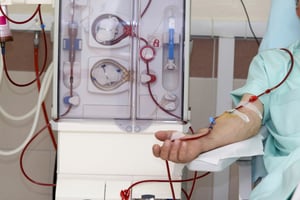Access Thrombosis Causes Major Problems for the Patient, Care Staff and Nephrologist
When an access suddenly clots or thromboses, all stakeholders are confronted with a crisis that must be immediately resolved.
Needless to say, the end-stage renal disease (ESRD) patient has the most at stake and can suffer the most. He or she must cope with:
- Discomfort, pain, anxiety and fear
- Delay of dialysis
- Concerns about K+ and fluid
- Disruption to schedule
- Decreased quality of life
The Dialysis Care Team is also affected. The staff needs to:
- Assist the patient in coping
- Arrange for transportation
- Interface between patient and physicians
- Rearrange dialysis schedule
The nephrologist may have to:
- Console a unhappy patient and family
- Arrange for logistics to resolve AVF failure
By trending vascular access flow measurements over time with the Transonic Hemodialysis Monitor, falling access flows will identify a developing stenosis which can then be proactively treated before it clots or thromboses. All stakeholders, the patient, the staff and the nephrologist win, by not having to confront the crisis that a thrombosed access creates.
“The Transonic Flow-QC Hemodialysis Monitor has benefited numerous dialysis-dependent patients by reducing and, in many cases, eliminating the agony of a clotted AV graft or fistula, thereby facilitating correction of access stenoses on an elective basis that prevents missed dialyses and the need for placing temporary catheters.” Depner T, MD, UC Davis
Reference:
Besarab A, Asif A, Roy-Chaudhury P, Spergel LM, Ravani P, “The native arteriovenous fistula in 2007. Surveillance and monitoring,” J Nephrol 2007;20:656-667. (Transonic Reference # HD7594A)



